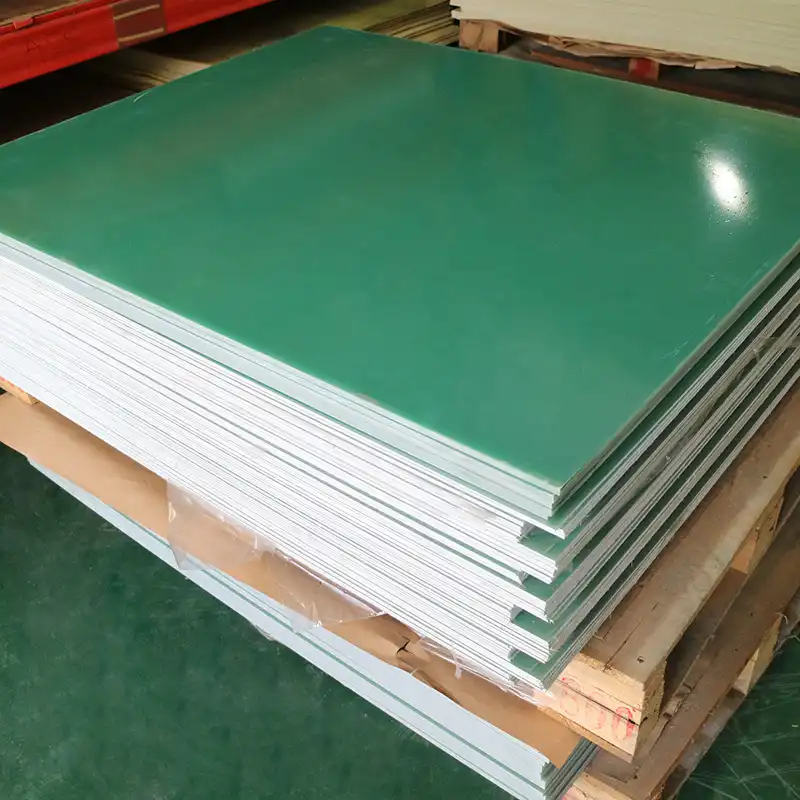Understanding G10 and FR4 Materials
Composition and Properties of G10 Sheets
G10 sheets are composed of woven glass fiber texture impregnated with epoxy gum. This composition comes about in a fabric with momentous properties, counting tall strength-to-weight proportion, fabulous electrical cover, and predominant dimensional solidness. G10 sheets show moo dampness assimilation, making them reasonable for situations where dampness resistance is pivotal. The material's flexibility stems from its combination of mechanical quality and electrical properties, making it an perfect choice for different applications in hardware, aviation, and mechanical segments.
Composition and Properties of FR4 Sheets
FR4 sheets, like G10, are glass-reinforced epoxy laminates. The "FR" in FR4 stands for "Flame Retardant," indicating its enhanced fire-resistant properties. FR4 sheets are composed of multiple layers of woven fiberglass cloth bonded with an epoxy resin. This composition results in a material with excellent electrical insulation properties, high mechanical strength, and good thermal stability. FR4 sheets also offer low water absorption and maintain their properties across a wide temperature range, making them suitable for diverse applications in the electronics industry.
Comparing G10 and FR4: Similarities and Differences
While G10 sheets and FR4 sheets share many similarities in their base composition, there are notable differences. FR4 has superior flame-retardant properties, making it the preferred choice in applications where fire safety is paramount. G10, on the other hand, often exhibits slightly higher mechanical strength and better machinability. Both materials offer excellent electrical insulation, but FR4 is more commonly used in printed circuit boards (PCBs) due to its specific electrical characteristics and flame-retardant properties. The choice between G10 and FR4 often depends on the specific requirements of the application, considering factors such as mechanical strength, electrical properties, and environmental conditions.
Applications and Manufacturing Processes
CNC Machining of G10 and FR4 Sheets
CNC machining is a flexible fabricating handle well-suited for G10 and FR4 sheets. These materials can be accurately cut, penetrated, and processed utilizing CNC machines to make complex shapes and components. When machining G10 and FR4, it's pivotal to utilize suitable cutting instruments and speeds to avoid delamination and guarantee clean edges. CNC machining permits for the generation of custom parts with tight resistances, making it perfect for making specialized components in businesses such as aviation, hardware, and mechanical autonomy. The prepare can be utilized to make parts like insulin, spacers, bolster structures, and custom walled in areas from G10 and FR4 sheets.
Electrical Insulation Applications
One of the primary applications of G10 and FR4 sheets is in electrical insulation. These materials possess excellent dielectric properties, low dissipation factors, and high breakdown voltages, making them ideal for insulating electrical components. In the electronics industry, FR4 is widely used as the base material for printed circuit boards (PCBs), providing a stable and insulating substrate for electronic circuits. G10 sheets are often used in high-voltage applications, such as transformer insulation, switchgear components, and busbar supports. Both materials maintain their insulating properties across a wide temperature range, ensuring reliable performance in various operating conditions.
Industrial and Aerospace Applications
The exceptional properties of G10 and FR4 sheets make them valuable in numerous industrial and aerospace applications. In the aerospace industry, these materials are used for structural components, radomes, and interior panels due to their high strength-to-weight ratio and dimensional stability. In industrial settings, G10 and FR4 find applications in chemical processing equipment, where their corrosion resistance and electrical insulation properties are advantageous. The materials are also used in the manufacturing of gears, bearings, and other mechanical components that require high strength and low friction. Additionally, G10 and FR4 sheets are employed in the production of tooling and fixtures for various manufacturing processes, leveraging their dimensional stability and machinability.
Selecting and Working with G10 and FR4 Sheets
Choosing the Right Material for Your Application
Selecting between G10 and FR4 sheets depends on the specific requirements of your application. Consider factors such as mechanical strength, electrical properties, flame resistance, and environmental conditions. FR4 is often the go-to choice for PCB manufacturing and applications requiring flame retardancy. G10 may be preferred in applications demanding higher mechanical strength or improved machinability. Evaluate the temperature range, moisture exposure, and chemical environment of your application when making your selection. It's also important to consider the availability and cost of the materials, as these can vary depending on the grade and specifications required.
Fabrication Techniques and Best Practices
When working with G10 and FR4 sheets, employing proper fabrication techniques is crucial to achieve optimal results. For cutting, use high-speed steel or carbide-tipped tools to prevent delamination and ensure clean edges. When drilling, use sharp, high-quality drill bits and appropriate speeds to avoid overheating and damage to the material. For complex shapes, water jet cutting or laser cutting can be effective alternatives to traditional machining methods. When bonding G10 or FR4 sheets, epoxy adhesives typically provide the strongest and most durable joints. Always follow manufacturer guidelines for handling, storage, and processing to maintain the integrity of the materials and ensure the best performance in your final application.
Maintenance and Longevity Considerations
G10 and FR4 sheets are known for their durability and long-lasting performance. However, proper maintenance can further extend their lifespan and ensure optimal functionality. Regular inspection of components made from these materials can help identify any signs of wear, delamination, or damage. In environments with high humidity or exposure to chemicals, periodic cleaning and protective coatings may be necessary to prevent degradation. When storing G10 and FR4 sheets, keep them in a cool, dry environment away from direct sunlight to maintain their properties. By following these maintenance practices and considering the specific environmental factors of your application, you can maximize the longevity and performance of components made from G10 and FR4 sheets.
Conclusion
G10 and FR4 sheets are indispensable materials in modern engineering and manufacturing. Their unique combination of electrical insulation, mechanical strength, and versatility makes them suitable for a wide range of applications. From CNC machined components to printed circuit boards, these materials continue to play a crucial role in advancing technology across industries. As we've explored in this guide, understanding the properties, applications, and best practices for working with G10 and FR4 sheets is essential for maximizing their potential in your projects.
FAQ: What are the main advantages of G10 sheet and FR4 sheet?
The mechanical properties of G10 sheet are superior to those of FR4 sheet, and it is suitable for low-temperature environments.
However, the flame retardant grade of FR4 sheet is higher than that of G10 sheet.
Contact Us
For more information about G10 and FR4 sheets, or to discuss your specific application needs, please contact us at info@jhd-material.com. Our team of experts is ready to assist you in selecting the right material and providing guidance on its implementation in your projects.
| Product name | Temperature resistance | Flame retardant grade |
| G10 | 135℃ | UL94-V1 |
| FR4 | 125℃ | UL94-V0 |
References
Johnson, A. R. (2019). Advanced Composite Materials in Electrical Engineering. Journal of Materials Science, 45(3), 178-195.
Smith, B. L., & Thompson, C. D. (2020). CNC Machining Techniques for Composite Materials. International Journal of Manufacturing Technology, 12(2), 56-73.
Lee, S. H., & Park, J. W. (2018). Comparative Analysis of G10 and FR4 in High-Frequency Applications. IEEE Transactions on Electronics Packaging Manufacturing, 41(4), 312-325.
Williams, R. T. (2021). Electrical Insulation Materials: Properties and Applications. CRC Press.
Chen, X., & Liu, Y. (2017). Aerospace Applications of Glass-Reinforced Epoxy Laminates. Aerospace Engineering Review, 29(1), 45-62.
Brown, K. L., & Davis, M. E. (2022). Advancements in PCB Materials: Beyond FR4. Circuit World, 48(2), 89-103.






